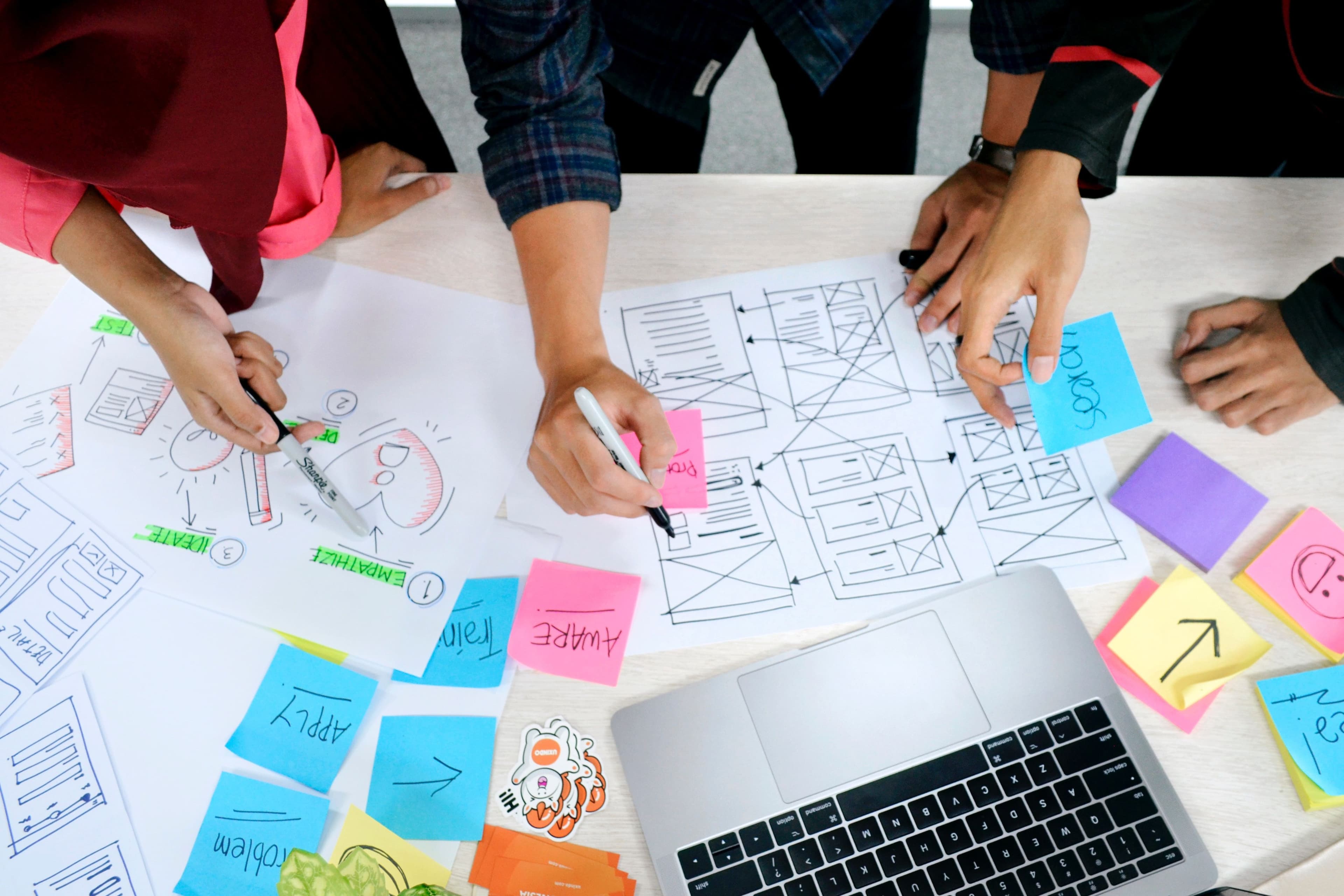Design has a powerful quality that renders desirability and appeals to both the products and services we use and create. Companies, now, aspire to ‘think’ like designers and make use of the design principles to excel at the workplace. Design thinking helps us to understand how to bridge the gap between thinking and doing in an effort of deepening what we know and widening the impact of what we do. Previously I wrote about the design thinker’s toolkit to highlight the tools and practices of individuals practising design thinking. This article aims to highlight the power of design thinking for teams and how design thinking is changing the way we work together in teams.
Design Thinking gives us the building blocks to focus on
I would summarise design thinking as a way of creative problem-solving that puts the user at the core of the process and further allowing the business goals and technical feasibility of the solution to have equal seats at the table. If we are truly seeking innovation as a company we need to look at those elements and what they represent in the problem we are facing. We do not need to solve all three (User, Technical, Business) at the same time, but by the end, we should have equally addressed all three in order to have a solid solution and any hope of innovation.
The building blocks are:
-
USER: Is what we are proposing desirable by people – would they want such a solution, does it fulfil their needs?
-
TECHNICAL: Is the solution we are proposing technically feasible, can we achieve it technically, or are we proposing something that might not be possible yet?
-
BUSINESS: Is it viable from a business perspective, can we make a healthy profit from a business perspective?
Design Thinking makes us project-focussed not title-focussed
A designer’s life is always arranged around projects. When you ask a designer how things are going or what they are up to, they start talking about the projects they are working on, not the latest title or promotion they’ve achieved. When looking at a designers portfolio, it is arranged according to their projects and what they contributed to the projects rather than their progression of titles.
What this means for a firm practising design thinking is that teams could be arranged around projects, everyone gets an equal seat at the table and opportunity to contribute to his or her team. It’s not about titles or hierarchy, but rather the design thinking ideology and users’ needs at the end of the day that prevail.
Design Thinking cultivates multi-disciplinary teams
While the design discipline is the main driver for design thinking, it does not own it. It’s no secret that design thinking is not an exclusive club for designers only. Design thinking stretches across multiple disciplines. We need an array of people, with varying skill sets in the room when practising design thinking. People are unique, their views might differ and it is exactly because of this variation in ideas and different perspectives that we need multi-disciplined people in the room. The true potential of design thinking is its collaborative force of bringing the disciplines together to create a team that has the ability to look at things holistically.
Design Thinking teams expect collaboration
The project-based work style emphasises collaboration. Projects are typically assigned to the team rather than to individuals. Even though the individuals within the team might take on (temporary) positions and roles (similar to the captain of a sports team), ultimately the solution is expected from the team (and not the captain).
The true sense of what sets one team apart from the next is how easy it is for them to collaborate and work together. Make no mistake, I’m not advocating for the team to sit together and work together all the time. It does take individual research and preparation followed by key strategic sessions of collaboration by the team to get the most of your team sessions.
Team members start talking about “our responsibilities” rather than “my responsibilities” and the job is not done until all team members are done.
Design Thinking is an iterative process
Design thinking is an iterative process where we, as a team, work our way through the process of Exploration, Creation to Implementation. Typically designers would produce a prototype during the creation phase ready for feedback, but managers are accustomed to final delivered projects.
The thing to realise is that design thinking will deliver results a lot faster, but they are not to be judged as final projects, rather they are unpolished prototypes ready for constructive criticism before going “back to the drawing board” to go through the process again. The way design thinking solves this divide is by recruiting their key stakeholders into the team.
Design Thinking teams recruit their stakeholders/clients
The key differentiating factor is how we involve the client or stakeholders in the process. The true power of design thinking is the ability to identify what we need to build before actually building it, and because of this reason we need to include the stakeholders in this process and as we are proposing and exploring solutions that they are part of the process. A lot of the time if an expected hypothesis is tested and it does not seem to be a viable option the stakeholders will come to the same conclusion with you and realise it is not feasible to pursue that avenue. This will result in no time or budget wasted down the wrong path, which the stakeholders will appreciate at the end of the day.
The closer we keep our stakeholders during this process the agiler our team will be to move and react to new knowledge discovered along the way.
Design Thinking teams see constraints as opportunities
Normally we might see constraints as the enemy, but designers take constraints as the boundaries that frame the problem we are trying to solve. They force you to be creative. They focus your attention and clarify your thinking. Rather than an enemy, constraints are features that make the task at hand more exciting, and the problem more wicked to solve. Instead of telling us what we cannot do, constraints help us reframe the problem and discover new opportunities along the way.
Think about the character constraints of Twitter where we have a 144 character limit. 144 characters are merely the boundary and create the opportunity for us to be creative in.
Design Thinking teams do not look back to predict the future
As analytical thinkers, we value reliability above validity and one thing that can predict reliable results is looking at the past to predict the future.
When you are practising design thinking, however, you have to be prepared to evaluate opportunities for what they can become and not from a perspective of what’s worked in the past. This is very difficult for companies that have built their products by critically analysing the past to chart a course for the future, this cannot be done when you are trying to innovate. The whole point is that you found a path no one has taken before, and this cannot be done by looking at the past.
Design Thinking unlocks abductive thinking
When first framing a problem to solve, design thinkers have to look at everything, because they don’t yet know what to leave out. The obvious danger comes in that what’s omitted might just prove integral to the solution. With little to go on by this stage, the design thinker employs abductive thinking to distill any patterns in what to others still seems very unclearly defined.
The design thinker that employs abductive thinking chooses to embrace a form of logic that doesn’t generate proof and operates in the realm of what might be, a realm beyond the reach of data from the past to prove reliable. Through abductive thinking, the design thinker comes up with a conclusion to the best explanation which does not guarantee any success. Typically it is these conclusions that encapsulate a prototype and gives the team something to test and learn from.
Design Thinking teams welcomes failure
Design thinking teams understand the uncertainty of abductive thinking and because of this, they allow for failure. The key difference is that we see failure as learning opportunities. Any failed hypothesis should inform us as to what didn’t work and fail in the hypothesis. This is why we welcome an iterative process, to fail fast and early ensuring we can avoid going down a path that won’t work. In the next iteration, we can focus on what worked and omit what didn’t.
Design Thinking makes people happy
According to John Maeda of the Rode Island School of Design, when people are challenged and have the freedom to be creative, they are happy. When a team can come together around a creative cause or a wicked problem, they want to come to work every day, to practice their design thinking skills to that extent! According to this logic, a tough design challenge might just be one of the best retentions tools a company today could apply for their best innovators.
To wrap it up
The only way to achieve success with design thinking is to see it as an essential activity to driving organisational change and innovation within our organisations. There are no half-hearted attempts, we’re either all in or not.
Above I’ve just started touching on various aspects of how design thinking will change the way we work in teams and how we go about creative problem-solving. As we grow as design thinkers so should our teams by embracing it and evolving with it. By doing this it will improve the products we buy and services we experience.








